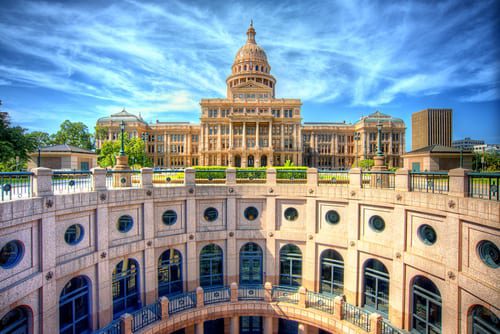
Texas is a state in the southern portion of the United States, famous for its BBQ, live music, hot temperatures, and scenic lakes and parks, but what is the capital of Texas?
The capital of Texas has switched hands a few times throughout its history. The state’s permanent capital was formally announced as Austin in 1845, when Texas became a part of the United States.
In this article, we will discuss what the capital of Texas is. So Keep reading; we have everything you need to know about Texas‘ capital.
Where is the Capital of Texas Located?

The capital of Texas is Austin, a city that is located around 80 miles northeast of San Antonio, where the Colorado River runs over the Balcones Escarpment. The broader metropolitan area of Austin includes the counties of Williamson, Caldwell, Bastrop, and Hays, as well as the cities of San Marcos and Round Rock.
Austin is the fourth largest city in the U.S and is known for its fantastic food, general weirdness, and live music. The nickname of this city is either bat city, a reference to the one million bats that nest around the Congress Avenue Bridge, or hippies haven due to the city’s easygoing nature.
A Brief History of Austin

The city of Austin hasn’t always been the bustling city that it is today. Long before the Europeans settled here, the Comanche, Tonkawa, and Lipan Apache Native Americans had lived around the area where the modern city stands today, hunting and living along the many creeks.
The indigenous history of Austin is long and complex. Some anthropologists have dated the earliest settlements in the area to around 37,000 years old. The early Native American tribes in this area were primarily nomadic and frequently moved their camps to follow the food supply.
At some point during the late 1700s, the Spanish sent missionaries to visit the area of Austin in an attempt to convert some of the Native Americans. A little less than a century later, during the 1830s, the first settlement of Anglos arrived in the area and named their village Waterloo.
Less than ten years after the Anglos made the first settlement in what would become Austin, the area was chosen by scouts working on behalf of the Republic of Texas as their capital. Judge Edwin Waller, the first mayor of the city, was the one who drew out the street plan that remains to this day. The area was named to honor Stephen F. Austin, known as the father of the Texas Republic.
In 1840, Austin was incorporated and had a population of nearly one thousand people. With threats of a Mexican invasion in 1842, the government decided it would be safer to move to Houston. Yet, the town’s citizens disagreed with this move and wanted to keep Austin as the capital, leading to the internal conflict known as the Archive War. This led to the people of Austin fighting to retain governmental records.
The government soon returned to Austin a few years later, in 1845, which just so happens to be the year in which Texas joined the United States as a permanent state on December 29, 1845.
During the 1880s, Austin began to resemble a great city. By September 1881, Austin had opened its first public schools, and only a few years later, they started working on constructing the enormous granite dam on the Colorado river. This provided electricity for the city and attracted manufacturers to the area.
In 1888, a pink granite capitol building was constructed in Austin and was based on the U.S Capitol. It was placed in an area where an earlier capitol building burned down.
When Did Austin Become the Capital of Texas?

In the early days of Texas’ independence, the capital city was moved from city to city fairly often, with places like Houston becoming the capital on multiple occasions. There have been at least five capitals of Texas, including Harrisburg, Velasco, West Columbia, and Austin.
By 1839, the settlement named Waterloo by Anglos colonists was renamed Austin and was chosen as the capital. By 1842, a few years after Texans came out victorious in the Battle of San Jacinto; the capital was moved to Houston.
The government of an independent Texas moved back to Austin in 1844. A year later, Texas was annexed into the United States, with Austin being officially named the capital of the state of Texas.
Why Is Austin The Capital of Texas?

The independent state of Texas went through a lot of options before it decided to choose Austin as its permanent capital.
While it didn’t become the official state capital until 1845, the founder of the colony, Stephen F Austin, chose the site as his unofficial capital back in 1824. He chose the area as it was a site he deemed easy to defend, perched on a high location with a bluff overlooking fertile lands.
Best Places To Visit in Austin
Austin can be an excellent place for a weekend trip away, and it has a great selection of sites to see and things to do. Here are five of the best places to visit in Austin
- Lady Bird Lake Hike and Bike Trail: This trail, named after a former Austin Mayor and his wife, is one of the most scenic trails in all of Austin. It takes you around Lady bird lake, through a reservoir on the Colorado lake, and is one of the best places to visit in Austin.
- Bartons Springs Pool: If you’re looking to go for a swim in a pool filled from a natural spring, the Bartons Springs Pool is not to be missed. This 1,000-foot natural limestone pool has it all, whether you’re looking to swim, fish, or enjoy a beauty pageant.
- LBJ Presidential Library: If you’re a history lover, you have to walk around the LBJ Presidential Library. The library and museum are focused on the United States’ 36th president, Lyndon Baines Johnson.
- Mount Bonnel: This is one of Austin’s oldest attractions, having been a site of interest since the 1800s. Mount Bonnel is a park with scenic views that looms almost 800 feet over the surrounding city.
- Congress Avenue Bridge Bat Watching: If you’re looking for an activity that’s a little outside of the box, then look no further than Bat Watching at the Congress Avenue Bridge. Around 1.5 million bats live under the bridge, which is a site to see.
